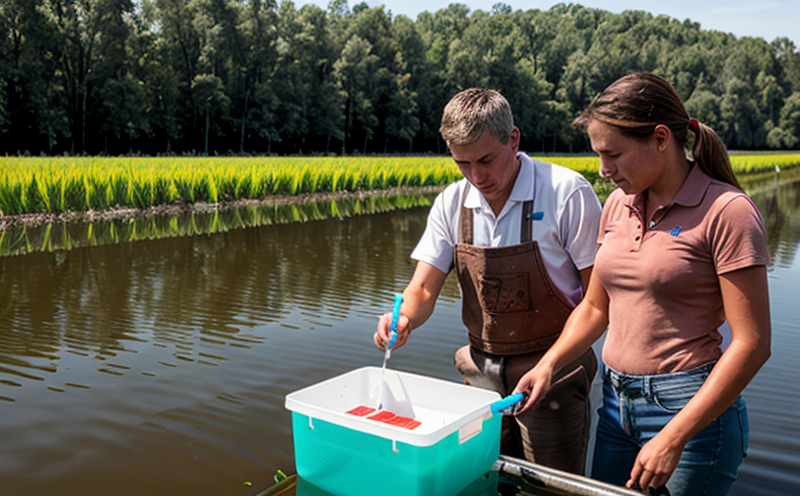Pesticide Residues Testing in Irrigation Water
Testing pesticide residues in irrigation water is a critical component of ensuring agricultural sustainability and food safety. Pesticides are widely used to protect crops from pests, weeds, and diseases, but improper use can lead to contamination of irrigation water. This contamination not only affects the quality of irrigation water but also poses potential risks to soil health, aquatic ecosystems, and human health.
The testing of pesticide residues in irrigation water helps farmers, regulatory bodies, and agricultural organizations monitor and control the levels of pesticides in their water sources. By identifying and quantifying the presence of pesticides, this service ensures compliance with international standards such as ISO 17025 and ASTM D6894.
The testing process involves several key steps: sample collection, extraction, purification, analysis using advanced instrumentation like gas chromatography-mass spectrometry (GC-MS) or liquid chromatography-tandem mass spectrometry (LC-MS/MS), and interpretation of results. The laboratory uses highly sensitive analytical techniques to detect even trace amounts of pesticides in irrigation water.
The primary goal is to ensure that the levels of pesticides do not exceed safe thresholds, thereby protecting both agricultural productivity and public health. By providing accurate and reliable test results, this service helps stakeholders make informed decisions regarding pesticide usage and water management practices.
| Key Parameters | Description |
|---|---|
| Pesticide Identification | Detection of specific pesticides used in agriculture |
| Quantification Limits | Absolutely necessary for ensuring safe pesticide levels |
| Sample Collection | From various sources including rivers, lakes, and wells |
| Testing Methodologies | Involves extraction, purification, and analysis using GC-MS or LC-MS/MS |
The process begins with the collection of water samples from different sources such as irrigation reservoirs, rivers, and wells. The collected samples are then processed to extract and purify the pesticides before being analyzed for their presence and concentration.
Understanding the impact of pesticide residues on crop health and soil quality is crucial for sustainable agriculture practices. By adhering to international standards like ISO 17025 and ASTM D6894, this service ensures that testing procedures are accurate and reliable. The laboratory uses state-of-the-art instrumentation and experienced personnel to provide precise results.
The importance of pesticide residue testing in irrigation water cannot be overstated. It plays a vital role in ensuring the safety and quality of agricultural products while also protecting the environment from contamination. By providing timely and accurate test results, this service helps stakeholders make informed decisions about their pesticide usage and water management practices.
Industry Applications
Pesticide residues testing is essential for a variety of industries involved in agriculture and forestry. Here are some key applications:
- Agricultural Industry: Monitoring the quality of irrigation water to ensure that pesticides do not exceed safe levels.
- Forestry Sector: Ensuring that pesticide residues in irrigation water do not affect tree health or soil quality.
- Water Management Agencies: Providing data for regulatory compliance and environmental protection.
| Pesticide Category | Common Residues |
|---|---|
| Insecticides | Acephate, Chlorpyrifos, Deltamethrin |
| Fungicides | Copper Sulfate, Mancozeb, Maneb |
| Herbicides | Glyphosate, 2,4-D, Bromoxynil |
The testing of pesticide residues in irrigation water is not only beneficial for agricultural and forestry sectors but also contributes to broader environmental and sustainability goals.
Customer Impact and Satisfaction
Our customers, which include quality managers, compliance officers, R&D engineers, and procurement specialists, benefit greatly from our pesticide residues testing service. By providing accurate and reliable test results, we help them make informed decisions regarding their water management practices and pesticide usage.
Customers appreciate the detailed reports that come with each test result, which provide a comprehensive overview of the pesticide levels in their irrigation water. This information is crucial for maintaining compliance with international standards such as ISO 17025 and ASTM D6894.
We also offer training sessions to help customers understand the importance of pesticide residues testing and how it impacts their operations. These sessions cover topics such as sample collection, extraction methods, and interpretation of results. By equipping our customers with this knowledge, we ensure that they can implement best practices for water quality management in agriculture.
Customer satisfaction is paramount to us, and we strive to provide services that meet or exceed expectations. We achieve this through rigorous quality control measures, experienced personnel, and cutting-edge instrumentation. Our commitment to accuracy and reliability has earned us a reputation as a trusted partner in the agricultural industry.
Environmental and Sustainability Contributions
The testing of pesticide residues in irrigation water contributes significantly to environmental protection and sustainability efforts. By identifying and quantifying pesticide residues, this service helps prevent contamination of soil and water bodies, which can have serious consequences for ecosystems and human health.
- Reduction in Pesticide Runoff: Proper testing ensures that pesticides are used efficiently, reducing the risk of runoff into nearby waterways.
- Soil Health Preservation: Ensuring safe pesticide levels helps maintain soil quality, which is essential for long-term agricultural productivity.
- Biodiversity Conservation: By preventing contamination, this service supports the health and diversity of local ecosystems.
The testing of pesticide residues in irrigation water aligns with broader sustainability goals such as the United Nations Sustainable Development Goals (SDGs). Specifically, it contributes to Goal 6: Ensure availability and sustainable management of water and sanitation for all, and Goal 15: Life on Land by protecting soil health and preventing contamination.





